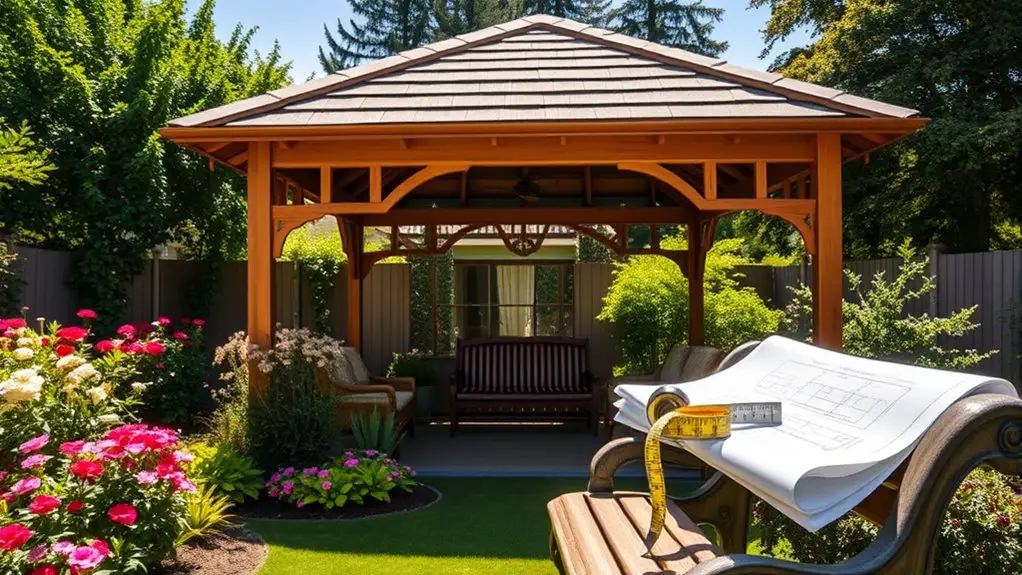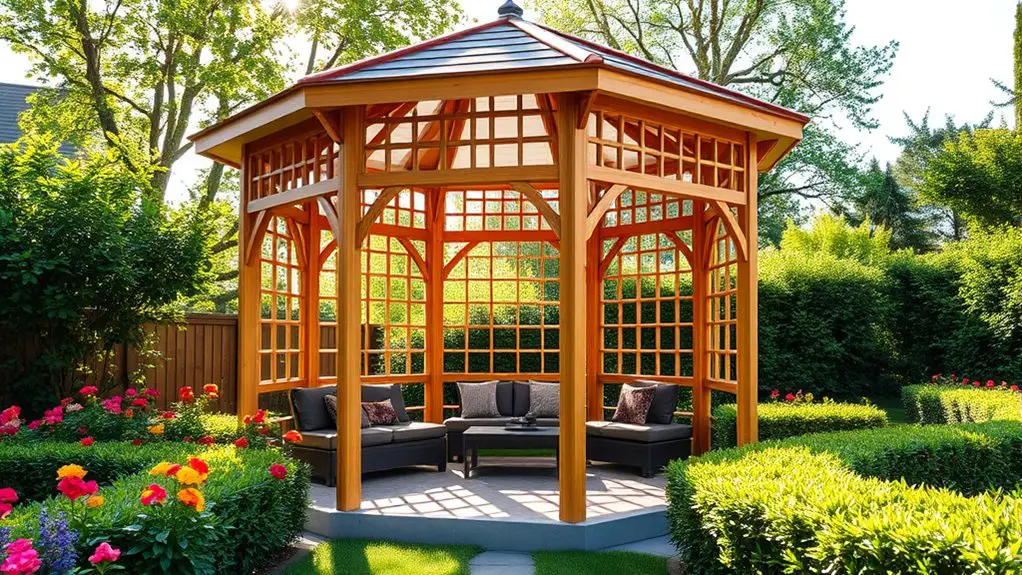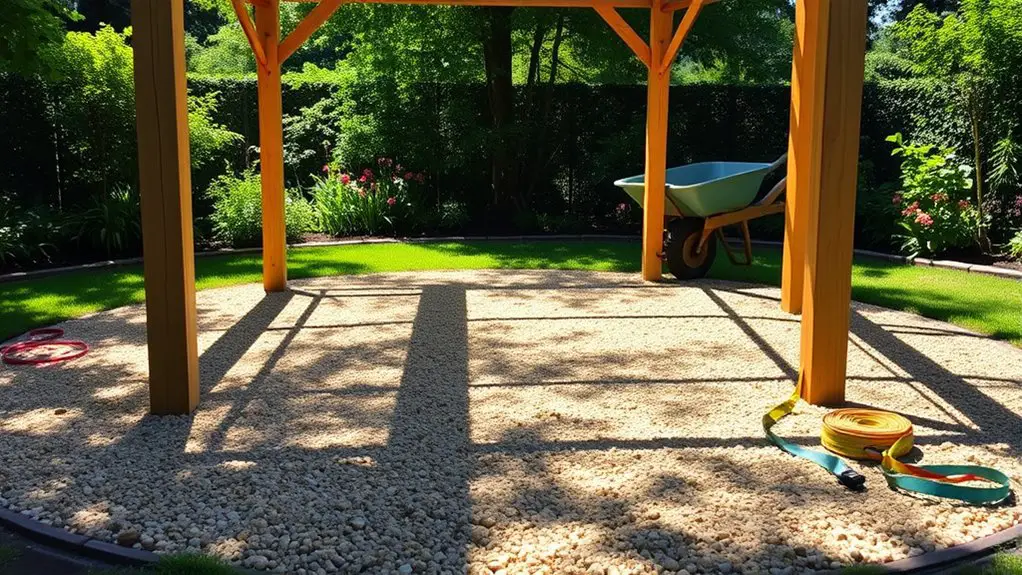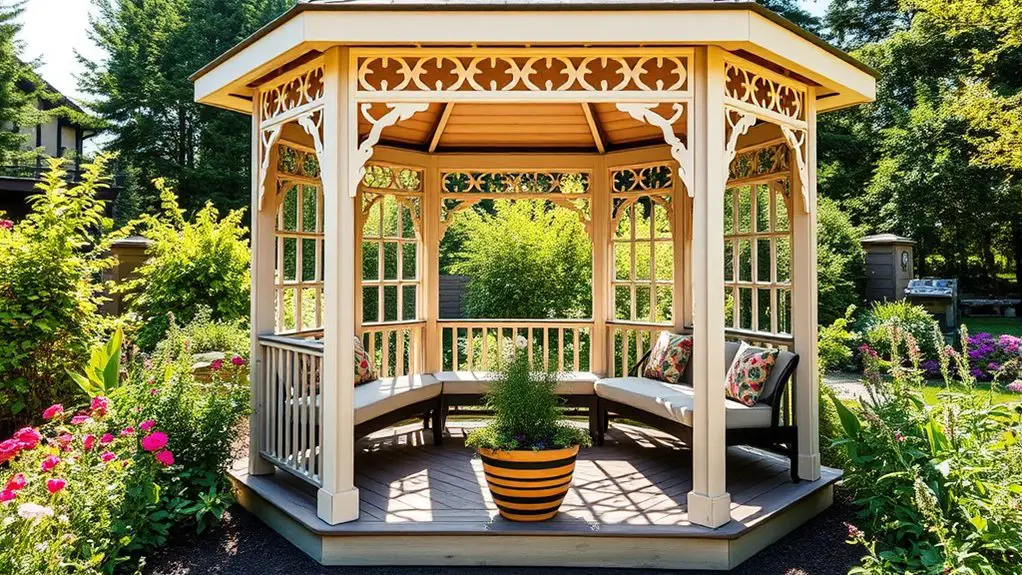To build a corner gazebo and maximize your space, start by evaluating your area’s dimensions, focusing on height and depth for the perfect fit. Choose a sunny yet private location, utilizing natural barriers for seclusion. Select a style that complements your home and landscape, and gather durable materials like treated wood or metal. Prepare the site by leveling the ground and selecting a strong foundation. Construct the structure carefully, then add finishing touches for comfort and ambiance. Discover more essential tips for a successful project.
Assessing Your Space and Needs

When figuring out where to place your corner gazebo, have you considered how much space you actually have? Understanding your space dimensions is essential. Start by measuring the area where you plan to install the gazebo. Consider the height, width, and depth of the structure to guarantee it fits harmoniously within your yard.
Next, evaluate your functional requirements. Think about how you envision using the gazebo—will it serve as a cozy reading nook, an outdoor dining area, or a shelter for gatherings? This will dictate the size and layout.
Keep in mind the surrounding elements—trees, fences, or other structures that could influence your design. By reviewing these factors carefully, you’ll create a sanctuary that not only fits your needs but also enhances your outdoor space, giving you the freedom to enjoy nature in style. Embrace the process and let your creativity flourish! Additionally, consider the surrounding landscape as it should complement natural beauty and existing features.
Choosing the Right Location
After evaluating your space and understanding your needs, it’s time to pinpoint the perfect location for your corner gazebo. Start by determining sunlight exposure; ideally, you want a spot that captures morning sunlight while providing shade in the afternoon. This not only enhances comfort but also protects your gazebo’s materials from harsh midday rays.
Next, consider privacy considerations. Position your gazebo away from busy pathways or neighboring properties to create a serene retreat. Natural barriers like trees or shrubs can enhance this sense of seclusion, making your space feel more intimate and inviting.
Additionally, think about accessibility. You’ll want to verify that it’s easily reachable from your home and any outdoor features, such as gardens or pools. By carefully weighing these factors, you can choose a location that maximizes both enjoyment and functionality, allowing your corner gazebo to become a cherished escape. Ensuring that your gazebo is on flat, sturdy ground is crucial for stability and longevity.
Selecting the Design and Style

When selecting the design and style for your corner gazebo, you’ll want to contemplate both aesthetic appeal and functionality. Think about how materials like wood, vinyl, or metal can complement your home while ensuring durability against the elements. With the right balance of design elements and material choices, you can create a stunning and practical outdoor space. Additionally, consider incorporating essential features such as lighting and seating to enhance usability and comfort.
Design Considerations
Selecting the right design and style for your corner gazebo is essential, as it not only enhances your outdoor space but also reflects your personal taste. When considering functionality versus aesthetics, think about how you’ll use the space. Do you envision entertaining guests, or enjoying quiet solitude? Make certain the design complements your existing landscape while maximizing space utilization. Open designs promote airflow and visibility, while enclosed styles offer privacy and shelter. Choose materials and colors that harmonize with your home, creating a seamless change. Incorporate features like built-in seating or lighting to enhance both beauty and utility. Ultimately, your gazebo should be a personal retreat, embodying your vision of freedom and relaxation in your outdoor haven.
Material Options
Choosing the right materials for your corner gazebo can greatly impact its durability, aesthetics, and functionality. You’ll want to weigh your options carefully between wood vs composite and metal vs plastic. Here’s a breakdown to help you decide:
- Wood: Offers a classic look but requires regular maintenance to prevent rot.
- Composite: Combines wood fibers and plastic for durability, with less upkeep but can be pricier.
- Metal: Provides strength and longevity, often resistant to weather, but may lack warmth.
- Plastic: Lightweight and low-maintenance, yet it might not withstand heavy winds or provide the same elegance.
Choose wisely, as each material will shape the experience and beauty of your gazebo, maximizing your outdoor space.
Gathering Materials and Tools
Before you start building your corner gazebo, it’s vital to gather all essential materials and tools. You’ll need an extensive overview of required supplies, from lumber to fasteners, as well as the right tools to guarantee precision in your construction. Don’t forget to include a safety equipment checklist to protect yourself throughout the process.
Essential Building Materials
As you commence your corner gazebo project, gathering the right materials and tools is essential to guarantee both structural integrity and aesthetic appeal. You’ll want to focus on selecting quality wood types that assure durability and weather resistance. Here’s a quick list of essential materials:
- Pressure-treated lumber: Ideal for posts and framing due to its resistance to rot.
- Cedar or redwood: Excellent choices for the exterior, offering natural weather resistance and beauty.
- Marine-grade plywood: Perfect for flooring, as it withstands moisture well.
- Shingles or metal roofing: Choose based on style preference and longevity against the elements.
With these materials, you’re on your way to creating a stunning and sturdy corner gazebo!
Required Tools Overview
Along with high-quality materials, having the right tools on hand is key to successfully building your corner gazebo. Start by gathering essential tool types, such as a power drill, saw, measuring tape, and level. Each tool plays a crucial role in ensuring accuracy and efficiency throughout your project. Don’t forget hand tools like hammers and screwdrivers for detailed work.
Prioritize tool maintenance to keep everything in top shape; clean and lubricate your tools regularly to prolong their lifespan. A well-maintained tool not only performs better but also enhances safety and comfort during use. By equipping yourself with the right tools and caring for them, you’ll empower your creativity, turning your vision into a stunning outdoor space.
Safety Equipment Checklist
When building your corner gazebo, having a thorough safety equipment checklist is essential to protect yourself during the project. Prioritizing safety gear guarantees you’re aware of potential hazards and can work confidently. Here’s a checklist to get you started:
- Safety goggles – Protect your eyes from debris and dust.
- Work gloves – Shield your hands from sharp tools and materials.
- Dust mask – Prevent inhalation of harmful particles, especially when sanding or cutting.
- Steel-toed boots – Safeguard your feet from heavy items and provide traction on uneven surfaces.
Preparing the Site
Preparing the site for your corner gazebo is an essential step that lays the foundation for a successful build. Start by choosing the right location, considering sunlight, shade, and accessibility. Clear the area of debris, plants, and rocks.
Next, focus on leveling the ground. An even surface is important for stability, so use a measuring tape and level to guarantee accuracy. Additionally, it’s crucial to check for underground utilities before starting any digging to ensure safety.
| Step | Description |
|---|---|
| Clear the Area | Remove any obstructions and debris. |
| Measure & Mark | Outline your gazebo’s dimensions. |
| Level the Ground | Use a level to guarantee an even surface. |
Once you’ve completed these site preparation tasks, you’ll be ready to move forward with confidence. A well-prepared site not only enhances the beauty of your gazebo but also promotes longevity, allowing you to enjoy your outdoor space freely and comfortably.
Building the Foundation

As you commence on building the foundation for your corner gazebo, ensuring a strong and stable base is essential for the structure’s longevity and safety. Proper ground preparation sets the stage for your gazebo, allowing you to choose the right foundation types based on your site conditions. Here are four key steps to follow:
- Clear the Area: Remove debris, grass, and any vegetation to create a clean workspace.
- Level the Ground: Use a shovel or rake to level the surface, ensuring it’s even for your foundation.
- Choose Your Foundation Type: Decide between concrete slabs, piers, or gravel pads, based on your gazebo size and local climate. A sturdy foundation is crucial to prevent shifting or sinking over time.
- Install Edging: For added stability, install landscape edging around the foundation area to keep materials in place.
Constructing the Gazebo Structure
Now that you’ve laid the foundation, it’s time to construct the gazebo structure itself. You’ll want to choose materials that not only complement your landscape but also guarantee durability and stability. As you design, keep in mind the structural integrity; a well-thought-out design will withstand the elements and provide a safe retreat for years to come. Consider using durable materials such as aluminum or cedar for optimal longevity and aesthetic appeal.
Choose Suitable Materials
Selecting the right materials for your corner gazebo is essential to ensuring its durability and aesthetic appeal. Consider these four key options to enhance your project:
- Composite materials: These offer strength and longevity while requiring minimal maintenance, making them a smart choice.
- Pressure-treated wood: Known for its resistance to rot and pests, this option gives a classic, natural look.
- Metal framing: Lightweight yet strong, metal can provide a modern touch and withstand severe weather conditions.
- Weather resistant finishes: Applying these to your selected materials will protect against moisture and UV damage, preserving their appearance over time.
Design for Stability
When designing your corner gazebo, it’s essential to prioritize stability, ensuring the structure can withstand both environmental stresses and the test of time. Start by considering key stability factors, such as wind resistance and weight distribution. Use durable materials for your structural supports, like treated wood or metal brackets, to enhance strength. Incorporate diagonal bracing to fortify the corners, preventing sway. Securely anchor the gazebo to the ground with concrete footings or heavy-duty anchors to resist uplift during storms. Don’t forget to plan for a solid roof that evenly distributes weight. By focusing on these elements, you’ll create a corner gazebo that’s not just a beautiful retreat but also a steadfast sanctuary for years to come.
Adding Roof and Walls
Adding the roof and walls to your corner gazebo is an essential step that not only enhances its aesthetic appeal but also provides protection from the elements. Choosing the right roof design and wall materials can transform your gazebo into a cozy retreat. Here’s a quick guide to get you started:
- Roof Design: Opt for a gabled or hip roof for better water runoff and a classic look.
- Wall Materials: Consider wood, vinyl, or glass panels based on your style and climate needs.
- Ventilation: Incorporate vents in the roof to prevent heat buildup and guarantee airflow.
- Insulation: If you plan to use the gazebo year-round, think about insulating the walls for comfort. Additionally, ensure that the roof is water-resistant to protect the interior and foundation from moisture.
Finishing Touches and Decor
To truly make your corner gazebo feel like an extension of your home, incorporating thoughtful finishing touches and decor is key. Start with lighting options that create ambiance—string lights or lanterns can add warmth and charm. Consider solar-powered fixtures for an eco-friendly touch.
Next, focus on furniture arrangement. Opt for versatile pieces like foldable chairs or a small bistro table to maximize space while guaranteeing comfort. Layer textiles with outdoor cushions and throws to invite relaxation.
Maximize comfort in your gazebo with versatile furniture and cozy textiles like cushions and throws.
Don’t forget greenery; potted plants or hanging baskets can breathe life into your gazebo. Adding personal decor items, such as artwork or decorative pillows, can express your style and make the space uniquely yours. Additionally, incorporating comfortable seating options will enhance the overall enjoyment of your gazebo while ensuring guests feel welcomed.
Finally, make certain your gazebo remains functional by keeping pathways clear and maintaining a cohesive color palette. With these finishing touches, your corner gazebo will transform into a cozy retreat that enhances your outdoor living experience.
Maintenance Tips for Longevity
While maintaining your corner gazebo might seem like a chore, a few simple practices can greatly extend its lifespan and keep it looking pristine. To guarantee your sanctuary remains inviting, follow these seasonal maintenance tips:
- Inspect Regularly: Check for any signs of wear or damage. Look closely at joints and hardware.
- Clean Thoroughly: Remove dirt and debris using a gentle soap solution. This prevents mold and decay.
- Apply Protective Coatings: Every few years, consider reapplying stains or sealants to protect wood from the elements and UV rays.
- Trim Surrounding Vegetation: Keep plants and branches at bay to avoid moisture retention and pest attraction. Additionally, regular inspections for damages are crucial to ensure both safety and longevity of your gazebo.
Frequently Asked Questions
What Is the Ideal Size for a Corner Gazebo?
Think of your corner gazebo as a cozy nook in your backyard. Ideal dimensions typically range from 8×8 to 12×12 feet. Consider your space and design preferences to create a harmonious outdoor retreat that breathes freedom.
Can I Build a Gazebo on a Slope?
You can build a gazebo on a slope by ensuring slope stability. Consider foundation options like piers or posts to secure it effectively. This way, your structure remains safe and functional, embracing nature’s contours beautifully.
How Much Does a Corner Gazebo Typically Cost?
A corner gazebo’s cost typically ranges from $2,000 to $10,000, influenced by factors like materials, size, and intricate gazebo styles. Understanding these cost factors helps you choose the perfect design that fits your budget.
Are Permits Required for Building a Gazebo?
Oh, the thrilling permitting process! You’ll often need permits for your gazebo, depending on local regulations. So, before you release your creative vision, check with your municipality—freedom sometimes requires a little paperwork patience!
What Materials Are Best for Gazebo Durability?
For durability, consider wood versus metal. While metal offers strength, treated wood with weather-resistant coatings enhances longevity. Choose materials that withstand elements, ensuring your gazebo remains a beautiful retreat, regardless of nature’s whims.

